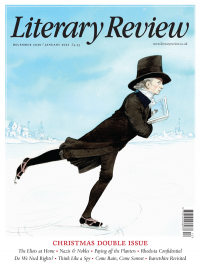Tom Stern
The Verification Code
The Murder of Professor Schlick: The Rise and Fall of the Vienna Circle
By David Edmonds
Princeton University Press 313pp £22
In 1952, Philipp Frank came to the attention of the FBI director, J Edgar Hoover, as a possible communist sympathiser. Frank, an immigrant, had been a member of the Vienna Circle, a group of philosophers that had met from the mid-1920s to the mid-1930s. Visited by FBI agents, Frank showed them the passage in one of Lenin’s books in which Lenin savaged a paper of his. He might have added that Einstein rather liked it. Frank was one of many individuals, men and women, who played important roles in the Circle. The best known are Rudolf Carnap, Otto Neurath and Moritz Schlick, who was the leader of the group until his murder in 1936. In truth, beyond the academy, the Circle boasted no big names but, as the Frank story indicates, there were plenty on its periphery. Einstein, Wittgenstein, Russell and Popper all took their ideas seriously. A J Ayer and W V O Quine visited Vienna to meet its members; both would shape 20th-century Anglophone philosophy, drawing on their Viennese expeditions. The Circle developed a philosophical outlook known as ‘logical positivism’ or ‘logical empiricism’ – the former term is more famous; the latter fits better. This book is a readable popular history of the Circle that deftly integrates the ideas and lives of its members with the story of the Viennese

Sign Up to our newsletter
Receive free articles, highlights from the archive, news, details of prizes, and much more.@Lit_Review
Follow Literary Review on Twitter
Twitter Feed
It wasn’t until 1825 that Pepys’s diary became available for the first time. How it was eventually decrypted and published is a story of subterfuge and duplicity.
Kate Loveman tells the tale.
Kate Loveman - Publishing Pepys
Kate Loveman: Publishing Pepys
literaryreview.co.uk
Arthur Christopher Benson was a pillar of the Edwardian establishment. He was supremely well connected. As his newly published diaries reveal, he was also riotously indiscreet.
Piers Brendon compares Benson’s journals to others from the 20th century.
Piers Brendon - Land of Dopes & Tories
Piers Brendon: Land of Dopes & Tories - The Benson Diaries: Selections from the Diary of Arthur Christopher Benson by Eamon Duffy & Ronald Hyam (edd)
literaryreview.co.uk
Of the siblings Gwen and Augustus John, it is Augustus who has commanded most attention from collectors and connoisseurs.
Was he really the finer artist, asks Tanya Harrod, or is it time Gwen emerged from her brother’s shadow?
Tanya Harrod - Cut from the Same Canvas
Tanya Harrod: Cut from the Same Canvas - Artists, Siblings, Visionaries: The Lives and Loves of Gwen and Augustus John by Judith Mackrell
literaryreview.co.uk